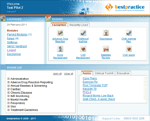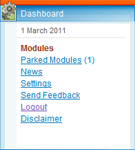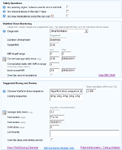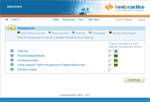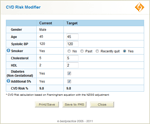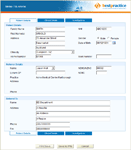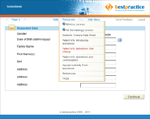Screenshots
This section contains screenshots of bestpractice Decision Support. The screenshots show some of the most commonly used bestpractice functionality. In order to view the screenshot at full size, simply click on the thumbnail.
Introduction to the Dashboard
The first screen you will encounter on logging into bestpractice is the Dashboard. The Dashboard provides access to the Decision Support modules as well as administrative functionality.
The Dashboard is shown in this screenshot. It is divided into several distinct areas. The area in the top left always contains the Main Menu, the content of the rest of the screen depends on the menu item selected in the Main Menu.
The default layout (that shown in this screenshot) is the Module layout. It consists of: the Main Menu, the Favourites pane, the Module pane and the Forms pane. These are examined in more detail in the Module screenshots section below.
Unlike most of the other Dashboard menu items, the Parked Modules menu item, pops up a window on top of the Dashboard. This window lists any modules that have been parked.
Selecting the News menu item displays the Recent News and News Item panes in the Dashboard. Clicking a link in the recent news pane shows that story in the news item pane.
Finding modules
All bestpractice functionality is contained within modules (more in-depth information about modules is available here). This means that finding the module you are looking for quickly and easily is very important. For this reason, there are several ways to view the modules installed on your system. You choose the method that works best for you. The screenshots below show where the various modules can be found and how to set up your favourites.
This screenshot displays the layout of the Dashboard when the Modules menu is selected (the Modules menu is the default when bestpractice is started). It consists of: the Main Menu, the Favourites pane, the Module pane and the Forms pane. The latter three panes are examined in greater detail below.
The Favourites pane provides fast access to your most popular modules. Modules can be added or removed from the Favourites pane through the Module List pane (below). Clicking on the Recently Used tab at the top of the Favourites pane displays the modules you have most recently used.
The Module List is a hierarchical listing by clinical area of all modules you have access to. Open a clinical area by clicking the 'plus' icon. Close a clinical area by clicking the 'minus' icon. To run a module, click the link (the blue text) that the module corresponds to.
To place a module into your Favourites pane, click in the box to the right of the module name. A tick will appear in the box and the module will appear in your Favourites. To remove a module from your Favourites pane, click on the box again. The tick will be removed from the box and the module will be removed from your Favourites.
The Forms pane provides access to a variety of useful forms. Some of these forms are accessible from within other modules. Clicking the the Clinical Toolkit tab displays a list of useful calculators. Clicking the Education tab displays a list of educational modules. Any of the modules from these tabs can be added to your Favourites by the same method outlined for the Module List above.
Features of modules
While there is a lot of variation between modules, there are some types of screens that appear often. In this way, despite each module dealing with different clinical concerns, there is consistency in the way they look and feel. The screenshots below showcase these generic screens. For more detailed information about how some of the more popular modules function, see the Full Module List
Most modules need to get some information before they can perfom their task, this is usually done with a data entry screen like that shown in this screenshot.
Where possible bestpractice will auto-populate fields from the PMS. Other fields will need to be completed by the health professional.
After the module has gathered the necessary information it will guide the health professional on possible treatment options. This is often done with a Management screen. Management screens provide a list of options and rate how desirable each is by way of a series of icons. The icons represent how strongly supported any course of action may be. They vary from ‘Highly Recommended’ to ‘Strongly Discouraged’.
The Cardiovascular Disease (CVD) Risk Modifier allows a healthcare provider to discuss ‘what if’ scenarios with a patient in relation to their CVD risk. The modifier shows a patient their current CVD risk and can demonstrate what would happen to their risk as they get older or if they made lifestyle adjustments, for example stopping smoking, lowered their blood pressure and/or cholesterol through lifestyle changes or by taking prescribed medication.
As a future development bestpractice will be integrated with the Heart Foundation’s ‘Your Heart Forecast’ tool which will provide a more graphical method of communicating CVD risk.
Summary screens within bestpractice allow providers to save a copy of their bestpractice interaction to their PMS. This summary can be printed to allow a patient to retain a copy of the consultation and the electronic copy can be easily accessed by the healthcare provider for future reference and audit.
bestpractice provides customised referrals. Where possible patient and provider details as well as relevant clinical information are populated from the PMS including any data entered while using a particular decision support module.
In some areas an electronic copy of this referral can be transmitted to triage centres for processing, with appropriate acknowledgement and feedback to the referrer. A copy of the referral is saved to the PMS to facilitate audit and review.
All modules provide additional information, functionality and links specific to that module through the Resources menu. It is always a good idea to check the content of this menu.
See also
Featured module

The INR Monitoring module utilises a formula developed by Ryan et al which assists clinicians adjust oral anticoagulant doses in patients. It also recommends the time interval for the next follow up visit and prints a Patient Dose calendar if required.
For more modules see the full list of standard modules.
Latest News
ACC18 Enhancements - Effective 27 November
Calendar, Printing and ACC Identifiers
In response to feedback, the online ACC18 continues to launch enhancements; the following will be available from 27 November.
Fitness for Work Tab - Calendar: Moving the mouse over the calendar for longer periods has been made easier.
Declaration Tab - ACC Identification: There will be a reduction in the number of identifiers from five to four; no direct impact on the Provider.
If you are one of the over 2000 Practitioners who regularly use the online ACC18; thank you. If you are not then now would be a good time to begin, noting that additional return to work assistance for patients is offered solely through this online form. Self service for setting up and using the online ACC18 is available at www.acc.co.nz (use keyword eACC18 Self Service). However, feel free to contact ACC at 0800 222 994 or ebusinessinfo@acc.co.nz for more personalised support.
Most Popular Modules
The five most popular modules in June were:
- Patient Prompt
- The Common Form
- e-Referral System
- ACC 18 Form
- CVD Quick Screen
To see more, go to the Statistics page.
Getting Started guide
The Getting Started guide is a good place to start if you are new to bestpractice Decision Support. The articles in the guide provide a quick and focussed introduction to the areas of most interest to new users of bestpractice.
About BPAC Inc
bestpractice Decision Support is produced by BPAC Inc. To find out more about us, click here.








